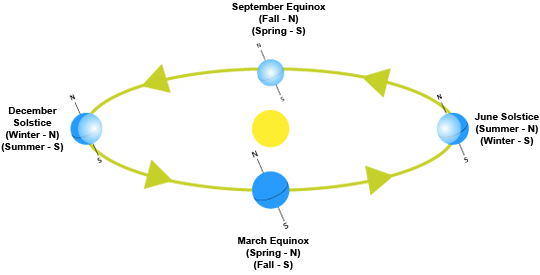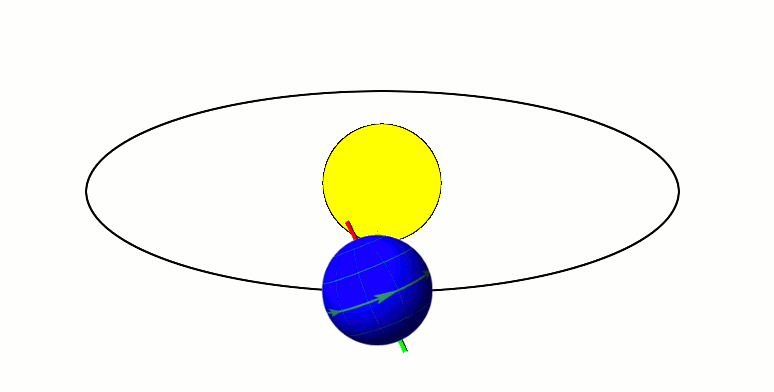The Seasons
The seasons change over the year as the Earth circles the Sun. Many people think that the seasons are caused by how far the Earth is from the Sun. The thought is that when it’s cold, the Earth is far away from the Sun and when it’s hot, the Earth is close to the Sun. If this were true, the seasons would be the same in the northern and southern hemispheres of the Earth. People in Australia would have summer time when people in the United States also have summer time, but this isn’t true. When it’s summer time in the United States, it’s winter time in Australia.


The seasons are caused by the way that the Earth sits, also described as the tilt of its axis, which is like a line through the center of the Earth. The tilt of the axis changes the angle between the Sun’s rays (solar radiation) and the surface of the Earth. When the northern hemisphere is tilted towards the Sun, the days are longer and lots of direct solar radiation lands on its surface, warming the air and land.
At the same time, on the southern hemisphere, the days are shorter and less light lands on the surface of the Earth, causing it to cool. As the Earth circles around the Sun, the northern and southern hemispheres reverse their positions. As each hemisphere faces towards or away from the Sun in turn, we experience the changing seasons. Learn how the changing seasons affect life on Earth.
Additional images via Wikimedia Commons. Leaves turning colors by Bengt Nyman.
Read more about: Singing in the Rain
Bibliographic details:
- Article: The Seasons
- Author(s): Dr. Biology
- Publisher: Arizona State University School of Life Sciences Ask A Biologist
- Site name: ASU - Ask A Biologist
- Date published: 9 Jun, 2012
- Date accessed: 16 May, 2025
- Link: https://askabiologist.asu.edu/seasons
APA Style
Dr. Biology. (Sat, 06/09/2012 - 11:10). The Seasons. ASU - Ask A Biologist. Retrieved from https://askabiologist.asu.edu/seasons
Chicago Manual of Style
Dr. Biology. "The Seasons". ASU - Ask A Biologist. 09 Jun 2012. https://askabiologist.asu.edu/seasons
MLA 2017 Style
Dr. Biology. "The Seasons". ASU - Ask A Biologist. 09 Jun 2012. ASU - Ask A Biologist, Web. https://askabiologist.asu.edu/seasons

Signals of change. In some areas of the world, changing leaf color is a sign of cooler weather from a change in the season.
Be Part of
Ask A Biologist
By volunteering, or simply sending us feedback on the site. Scientists, teachers, writers, illustrators, and translators are all important to the program. If you are interested in helping with the website we have a Volunteers page to get the process started.




